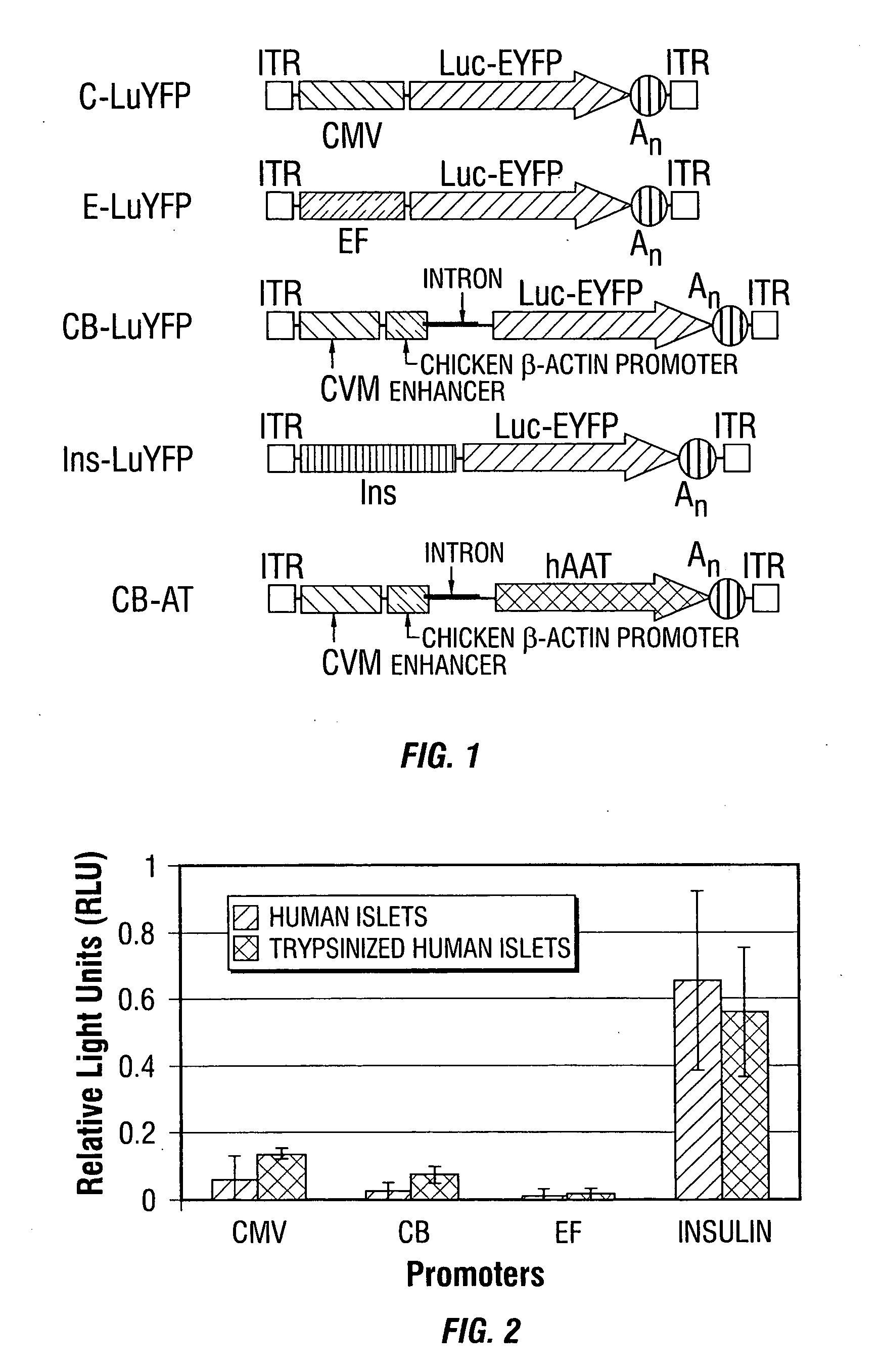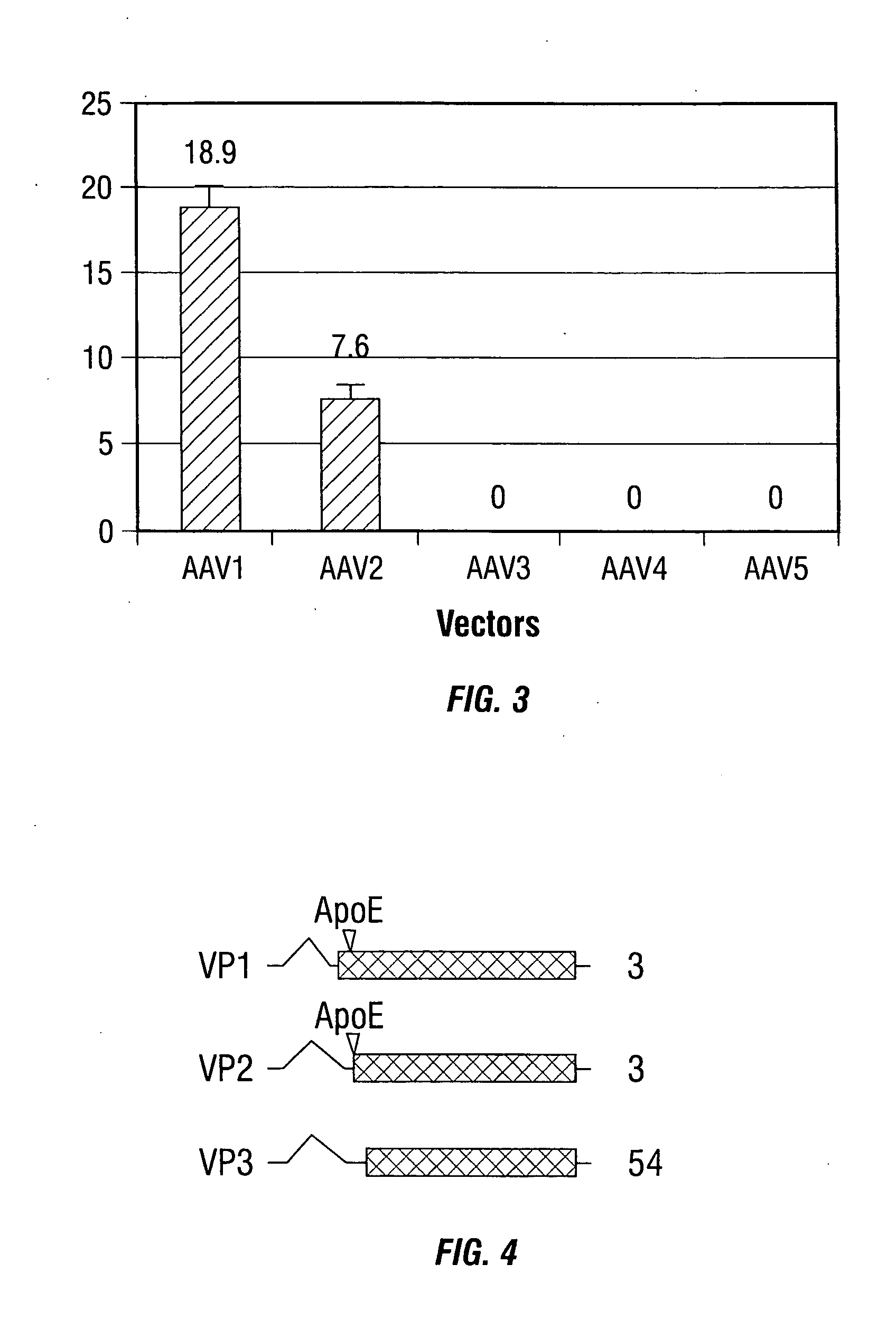Improved rAAv vectors
a technology of raav and vector, applied in the field of molecular biology and virology, can solve the problems of limited gene-therapy approaches, undesirable side effects, and inability to overcome, and achieve the effect of more efficient transduction of selected mammalian cells
- Summary
- Abstract
- Description
- Claims
- Application Information
AI Technical Summary
Benefits of technology
Problems solved by technology
Method used
Image
Examples
example 1
5.1 Example 1
Generation of Improved rAAV Vectors
[0246] In the present example, rAAV-mediated transduction has been enhanced by using alternative promoters, such as the human insulin promoter, and rAAV capsid mutants that incorporate a ligand derived from apolipoprotein E (ApoE) that is targeted to the low density lipoprotein receptor (LDL-R) (Datta et al., 2000). These studies indicate that the transduction efficiency can be enhanced several thousand-fold, allowing for the use of MOIs as low as 5 i.u. per cell. These studies demonstrate the use of modified rAAV vectors for islet cell transduction.
5.1.1 Materials and Methods
5.1.1.1 Plasmid Constructs and rAAV Packaging
[0247] The rAAV serotype 2 (rAAV2) vector plasmids used for these studies are depicted diagrammatically (FIG. 1). Briefly, the CMV-β-actin promoter from pCB-hAAT (Xu et al., 2001), the elongation factor promoter and the human insulin promoter were cloned into the KpnI and HindIII sites of pTR-CMV-lucEYFP replacin...
example 2
5.2 EXAMPLE 2
Efficient Ex Vivo Transduction of Pancreatic Islet Cells with Improved rAAV Vectors
[0269] Attempts to use islet cell transplantation for reversing type 1 diabetes have been documented for more than two decades; however, the procedure has been largely unsuccessful (Kenyon et al., 1998; Weir and Bonner-Weir, 1998). Concurrent mechanisms believed to underlie this lack of success include rejection, recurrence of anti-islet cell autoimmunity, and nonspecific islet loss because of perturbation of the graft microenvironment (e.g., inflammation, ischemia / reperfusion).
[0270] A number of candidate gene products may prevent immune-mediated destruction and extend graft survival (e.g., interleukin [IL]-4, manganese superoxide dismutase, Bcl-2) (Giannoukakis et al., 1999). Furthermore, these genes may prove safer and more effective than systemic pharmacological immunosuppression because some agents are themselves potentially prodiabetogenic (e.g., cyclosporine, FK506, steroids) th...
example 3
5.3 EXAMPLE 3
Mutational Analysis of the AAV2 Capsid Gene and Construction of AAV2 Vectors with Altered Tropism
[0286] Adeno-associated virus type 2 (AAV2) belongs to the human parvovirus family, which requires a helper virus for production replication (Berns and Bohenzky, 1987; Buller et al., 1981; Casto et al., 1967). The nonenveloped capsid adopts an icosahedral structure with a diameter of approximately 20 nm. Packaged within the capsid is a single-stranded DNA genome of 4.7 kb that contains two large open reading frames (ORFs), rep and cap (Srivastava et al., 1983). Three structural proteins, designated VP1, VP2, and VP3, are encoded in the cap ORF and made from the p40 promoter by use of alternative splicing and alternative start codons. The three proteins share the same ORF and end at the same stop codon. The C-terminal regions common to all three capsid proteins fold into a β-barrel structure that is present in several viruses (Rossmann, 1989). Their molecular masses are 87,...
PUM
| Property | Measurement | Unit |
|---|---|---|
| temperature | aaaaa | aaaaa |
| temperature | aaaaa | aaaaa |
| pH | aaaaa | aaaaa |
Abstract
Description
Claims
Application Information
 Login to View More
Login to View More - R&D
- Intellectual Property
- Life Sciences
- Materials
- Tech Scout
- Unparalleled Data Quality
- Higher Quality Content
- 60% Fewer Hallucinations
Browse by: Latest US Patents, China's latest patents, Technical Efficacy Thesaurus, Application Domain, Technology Topic, Popular Technical Reports.
© 2025 PatSnap. All rights reserved.Legal|Privacy policy|Modern Slavery Act Transparency Statement|Sitemap|About US| Contact US: help@patsnap.com



